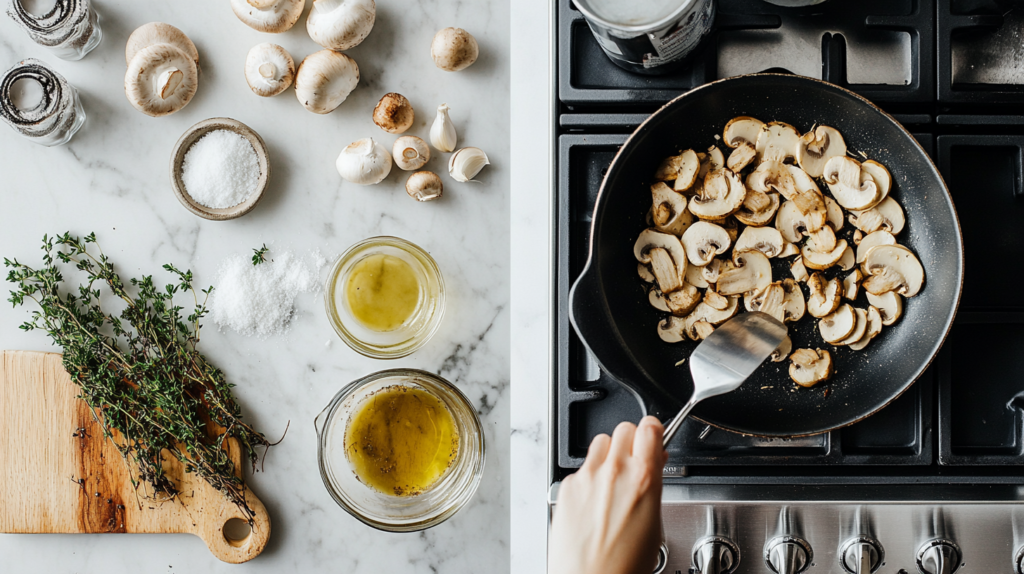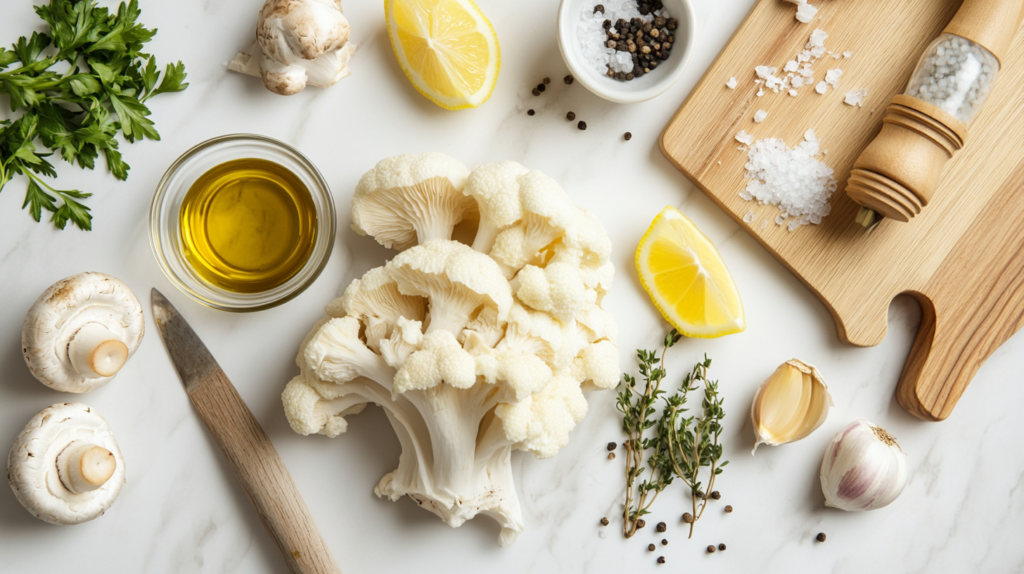If you’ve ever wondered what happens when a mushroom tastes like crab meat, looks like a fluffy pom-pom, and packs a punch of health benefits—meet your new favorite ingredient: lion’s mane mushroom. 🦁🍄
This isn’t just another trendy food. Lion’s mane is a wild culinary gem with rich flavor, incredible texture, and a unique ability to transform into everything from mock crab cakes to creamy pasta. Whether you’re vegan, paleo, or just hungry, this mushroom has something for you.
So, ready to explore a recipe that’s as good for your brain as it is for your belly? Let’s dive into the world of lion’s mane mushroom recipes and get cooking!
Introduction: Why Lion’s Mane Mushrooms Are Trending in Kitchens
It’s not every day that a mushroom steals the spotlight. But lion’s mane isn’t your everyday fungi.
Not only does it have a weirdly cool look—like a white, shaggy snowball—it’s also:
- Packed with cognitive and immune-boosting benefits
- Naturally meaty and satisfying (hello, plant-based protein!)
- Incredibly versatile in savory dishes
What’s more, lion’s mane has become a foodie favorite for those looking to reduce meat, embrace functional foods, or just try something new. It’s showing up in everything from health supplements to high-end restaurant menus—and now, it’s ready for your kitchen too.
“Cooking lion’s mane is like discovering a secret ingredient that’s been hiding in plain sight—wild, wonderful, and way tastier than you’d expect.” 🌿
What Is Lion’s Mane Mushroom? A Quick Overview
Lion’s mane mushroom (Hericium erinaceus) grows on hardwood trees and gets its name from its long, white, hair-like strands. But don’t let the name fool you—it’s more fluffy cloud than fierce jungle beast.
Its flavor? Subtle yet rich. People often describe it as having a seafood-like taste, somewhere between crab, scallops, and lobster. 🦀
Its texture? Soft and meaty, yet tender. When sautéed or roasted, it gets golden and crispy on the outside while staying juicy on the inside. Basically, it’s a dream come true for both vegans and omnivores.
Oh, and it’s not just tasty—it’s also a powerhouse of goodness:
- Supports brain health and memory 🧠
- Boosts the immune system
- May reduce anxiety and inflammation
“Lion’s mane is one of those rare ingredients that checks all the boxes—flavor, texture, and health. A triple win!” ✨
Health Benefits of Lion’s Mane Mushroom
Let’s talk real benefits for a second.
Lion’s mane is famous in the wellness world for its neuroprotective properties. Studies suggest it may stimulate nerve growth factor (NGF)—which is kind of like brain fertilizer. This makes it a go-to ingredient for anyone looking to boost focus, memory, or mental clarity.
It’s also loaded with:
- Antioxidants
- Beta-glucans
- Anti-inflammatory compounds
That means it’s not just good—it’s functional food at its finest.
What Does It Taste Like? Flavor and Texture Explained
This mushroom might be a flavor chameleon, but one thing’s for sure—it doesn’t taste like your average button mushroom.
When cooked, lion’s mane develops a slightly nutty, buttery, and sometimes seafood-like taste. It’s mild, which makes it a perfect canvas for spices, sauces, and marinades. The texture is firm but tender—almost like chicken or crab.
So yeah, if you’re looking for a mushroom that behaves like meat, this is the one. 💯
Where to Find and Buy Lion’s Mane Mushrooms

Alright, now you’re probably asking: Where do I actually get this stuff?
Lion’s mane used to be pretty rare unless you were hiking through a forest. But these days, it’s much easier to find—thanks to the boom in medicinal mushrooms and gourmet cooking.
Fresh vs. Dried vs. Powdered: What’s Best for Cooking?
- Fresh Lion’s Mane: Ideal for recipes. Look for it at local farmers markets, health food stores, or specialty mushroom farms. Fresh is best for texture and flavor.
- Dried Lion’s Mane: Good for teas or soups, but you’ll need to rehydrate it before using in recipes.
- Powdered Lion’s Mane: Great for smoothies and supplements—but not for cooking. This is more for brain health than dinner.
👉 Pro tip: If you can’t find it in stores, there are many farms that ship it fresh online!
Wild Foraging Tips (and Safety Warnings)
Feeling adventurous? You can forage lion’s mane in the wild, especially during fall in hardwood forests.
But—and this is a big but—never eat a wild mushroom unless you’re 100% sure it’s safe. Mistaking it for a lookalike could be dangerous.
If you’re new to foraging:
- Go with a trained mushroom guide
- Use multiple sources for identification
- Don’t rely on apps alone
Stay safe, friends. 🍄🚫
How to Clean and Prepare Lion’s Mane for Cooking
Once you’ve got your hands on some beautiful lion’s mane, don’t just toss it in a pan—a little prep goes a long way.
Cleaning Without Ruining the Texture
Lion’s mane acts like a sponge—so go easy on the water. Here’s how to clean it:
- Brush off any dirt with a dry cloth or soft brush
- If needed, use a lightly damp paper towel to wipe spots
- Avoid soaking it—this will ruin the texture!
If there are any brown spots or woody bits, simply trim them off with a sharp knife.
Slicing and Storing Tips
You can tear lion’s mane apart with your hands into bite-sized chunks—this helps maintain the natural structure and texture. Or slice it thick if you’re going for steaks or patties.
Storage: Wrap it in a paper towel, place it in a paper bag, and keep it in the fridge. It should stay fresh for up to 5–7 days.
Essential Ingredients for Lion’s Mane Mushroom Recipes

Lion’s mane is the kind of mushroom that plays well with others. While it has a unique flavor on its own, it can soak up whatever you throw at it—spices, sauces, aromatics—you name it.
So what should you keep handy in your kitchen when cooking lion’s mane?
Oils, Herbs, and Flavor Boosters That Pair Well
Let’s start with the basics.
- Olive oil or avocado oil: Perfect for sautéing; they complement the mushroom’s nutty notes.
- Butter or vegan butter: Adds richness and a golden sear.
- Garlic and shallots: These aromatics are a match made in heaven with lion’s mane.
- Fresh herbs like thyme, rosemary, or parsley: They bring earthy freshness that balances the mushroom’s deep flavor.
- Soy sauce or tamari: Just a dash adds umami magic.
- Lemon juice or zest: Brightens everything up at the end.
“Lion’s mane is like a sponge for flavor—it absorbs sauces and seasonings like a pro.” 🧄🌿🍋
The best part? You don’t need anything fancy. A hot pan, good oil, and a few fresh ingredients go a long way.
Vegan and Non-Vegan Pairing Options
No matter your dietary preference, lion’s mane can fit the bill.
Vegan ideas:
- Sauté with olive oil and garlic, then serve over quinoa or lentils.
- Toss into a creamy coconut curry with chickpeas and kale.
- Make plant-based “crab cakes” (we’ll get to that soon 👀).
Non-vegan ideas:
- Pair with grilled chicken or steak for a savory side.
- Stir into a creamy mushroom pasta with parmesan and white wine.
- Add to a buttery risotto for next-level comfort food.
It’s flexible, forgiving, and fun to cook with.
Easy Pan-Fried Lion’s Mane Mushroom Recipe
Now let’s get to the heart of it: a simple, foolproof way to cook lion’s mane mushrooms that delivers restaurant-worthy flavor—pan-fried perfection. 😍
Ingredients & Tools Needed
Here’s what you’ll need:
- 1 large lion’s mane mushroom (or a few small ones)
- 2 tbsp olive oil or butter
- 2 cloves garlic, minced
- Salt and pepper, to taste
- Optional: a squeeze of lemon, fresh parsley, or a pinch of smoked paprika
Tools:
- Sharp knife
- Cast iron skillet or nonstick pan
- Spatula
Step-by-Step Instructions
- Clean the mushroom using a soft brush or towel. Tear it into bite-sized pieces.
- Heat oil or butter in a skillet over medium heat until shimmering.
- Add the mushrooms in a single layer. Let them sit undisturbed for 2–3 minutes to get a nice sear.
- Flip and cook for another 2–3 minutes, then stir in the garlic.
- Season with salt, pepper, and any optional extras.
- Finish with a squeeze of lemon or a sprinkle of herbs for a fresh kick.
And that’s it! You’ve just created a dish that’s crisp on the outside, juicy on the inside, and bursting with earthy, buttery goodness. 🍄✨
“Pan-frying lion’s mane is like discovering your skillet’s best-kept secret. Simple ingredients, big flavor.” 🔥
Serving Suggestions
You can serve pan-fried lion’s mane:
- Over toast with avocado and chili flakes
- On top of creamy polenta or mashed potatoes
- Mixed into a grain bowl with roasted veggies
- As a side dish to your favorite protein
Or just eat it straight out of the pan—no judgment. It’s that good.
Common Cooking Mistakes (And How to Avoid Them)
Cooking lion’s mane mushrooms can be surprisingly simple—but a few rookie errors can turn your culinary masterpiece into a kitchen mishap. Let’s break down the most common problems and how to fix them.
Why Did My Mushrooms Turn Soggy?
This is probably the number one issue people run into.
The culprit? Too much moisture.
Lion’s mane mushrooms naturally hold a lot of water, especially if they’ve been washed too heavily or cooked on low heat.
How to fix it:
- Avoid soaking the mushrooms—wipe them clean instead.
- Always cook them in a hot pan to release moisture quickly.
- Let them sear undisturbed for the first few minutes instead of stirring constantly.
“Lion’s mane needs heat and patience—give it room to crisp up and shine.” 🔥
Fixing Bland or Bitter Flavor
If your mushrooms taste dull or bitter, a few things could be going wrong:
- Underseasoning: Lion’s mane has a mild flavor that craves salt, acid, and fat.
- Overcrowding the pan: Too many mushrooms will steam, not sear.
- Overcooking: They can develop a tough or bitter edge when left too long.
Try adding a splash of lemon juice, soy sauce, or even a dab of miso to punch up the flavor. And don’t skimp on the garlic and butter. 😉
Overcooking or Undercooking Issues
Lion’s mane is forgiving, but timing still matters.
- Undercooked = spongy or chewy
- Overcooked = dry and rubbery
Aim for golden brown edges and a soft, juicy interior. If in doubt, taste as you go!

FAQs About Cooking with Lion’s Mane
Still curious? Here are quick answers to the most common lion’s mane mushroom questions.
Can You Eat It Raw?
Technically, yes—but it’s not recommended. Raw lion’s mane is spongy and slightly bitter. Cooking enhances both the flavor and texture (plus it’s easier to digest).
Is It Safe for Kids or Pregnant Women?
In general, yes—especially when cooked properly. But as with any wild mushroom, consult your doctor if you’re pregnant, breastfeeding, or managing allergies.
Does It Taste Like Meat or Seafood?
Yes, and that’s what makes it so amazing! Many compare the taste to crab or lobster, especially when shredded and pan-fried. It’s one of the best meat substitutes for vegans who miss that texture.
“Lion’s mane is the mushroom that doesn’t taste like a mushroom—it’s a flavor shapeshifter.” 🍤🍄
You Might Also Enjoy These Wholesome & Flavor-Packed Recipes
Love the meaty, umami-rich texture of this Lion’s Mane Mushroom Recipe? Keep exploring nourishing, bold-flavored dishes and naturally nutritious ingredients right here on Call Me Recipes:
- Discover the power of tomatoes in your cooking with Roma Tomato Nutrition — learn how to use them for flavor and health benefits.
- Add creamy nutrition to your meals with this Mashed Avocado — perfect for breakfast, bowls, or toast.
- If you love rich, savory mains, don’t miss the Ribeye Roast Recipe — a guide to cooking beef perfection.
- For seafood lovers, these Rockfish Recipes offer easy ways to bring bold flavors to your table.
- Want to use up those bananas? Try the 2 Banana Bread Recipe — it’s simple, moist, and perfect for any day.
- Craving something sweet but low-carb? These Keto Apple Cider Donuts are a guilt-free fall treat.
- For classic comfort in a healthier way, check out the Keto Sticky Toffee Pudding — rich flavor with low sugar.
These recipes celebrate earthy ingredients, wholesome nutrition, and bold taste — perfect companions to your Lion’s Mane dish. Dive deeper into Call Me Recipes and find your next kitchen favorite!
Final Thoughts: Why Lion’s Mane Belongs in Your Recipe Book
Lion’s mane mushroom isn’t just a cool name with cool health benefits—it’s a versatile, delicious, and easy-to-love ingredient that deserves a regular spot in your kitchen.
Whether you’re:
- Cutting back on meat
- Trying new plant-based dishes
- Looking for a cognitive health boost
- Or just want something different and delicious…
Lion’s mane has your back.
From sauté pans to pasta bowls, from crab cakes to creamy risottos, this mushroom does it all—and makes you look like a kitchen rockstar while doing it.
So go ahead: grab some lion’s mane, fire up your skillet, and cook something wild. 🦁🔥
“Good food should nourish your body and your curiosity. Lion’s mane does both.”

